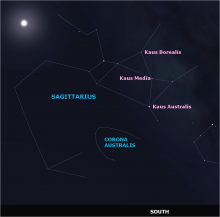Listen to today's episode of StarDate on the web the same day it airs in high-quality streaming audio without any extra ads or announcements. Choose a $8 one-month pass, or listen every day for a year for just $30.
You are here
Halloween
In Greek mythology, few creatures were scarier than the Gorgons. The three sisters had venomous snakes atop their heads, and faces so terrifying that a single glimpse turned the watcher to stone. And it just so happens that they climb high across the sky tonight. There’s no need to avert your eyes, though — the stellar versions are quite beautiful.
They’re in the constellation Perseus, the hero, which is in the northeast at nightfall. The Gorgons are there because Perseus killed one of the three sisters — the mortal Medusa. He later used her head to turn Cetus, the sea monster, to stone.
The constellation’s most famous star is Algol. Its name comes from the Arabic phrase “ras al ghul.” The phrase means “head of the demon,” so Algol is known as the Demon Star. It represents Medusa’s head.
The star got such a fearsome name because for a few hours every three days or so, it gets a good bit fainter — a change that wasn’t understood until the 19th century. Today, we know the dimming is caused by an eclipse between the two stars that make up the Algol system. The eclipse blocks the light of one of the stars.
Three fainter stars to the right of Algol form a small, lopsided box. These stars are the Gorgonea — the Gorgons. Each one represents one of the three sisters. The stars aren’t related, though — they just happen to lie in the same direction in the sky.
So enjoy these four stellar “demons” as you make your way through Halloween night.



